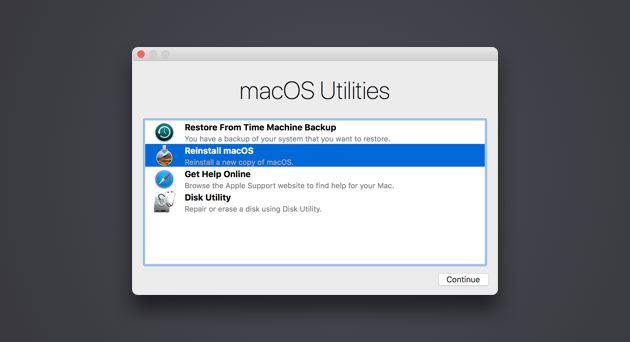
:max_bytes(150000):strip_icc()/001B-format-mac-drive-using-disk-utility-os-x-el-capitan-later-2260751-0860ad3f317a41de906bc99d092f5236.jpg)
- How to start disk utility on mac via terminal mac os x#
- How to start disk utility on mac via terminal install#
- How to start disk utility on mac via terminal software#
- How to start disk utility on mac via terminal password#
Enter your username and password if prompted, select the disk you want to boot from and then click "Restart. Once launched, type or paste in the following command. To change the startup volume from the System Preferences menu, click "Apple," select "System Preferences" and then click "Startup Disk" to display the Startup Disk window. Restart your Mac and press Command + R and keep them both pressed until you see the Utility menu (Recovery Menu) appearing. Launch Terminal from your Dock, Utilities folder, or via an app launcher like Alfred. Use the arrow keys to select the drive you want to boot from and then press "Enter" to use it. Beyond this graphical front-end are some powerful command-line tools that we can use directly. It's a simple way of interacting with attached storage on your Mac.
How to start disk utility on mac via terminal mac os x#
Just hold the "Option" key after you turn on or restart your Mac to display the Startup Manager. Disk Utility within Mac OS X provides a range of disk management tools, from erasing and repartitioning hard disks to restoring images and repairing volumes. You can change the startup disk while the Mac is booting. The command line approach to disk erasure in macOS is a bit different and it requires precise syntax to insure that you are erasing the proper disk.

If you prefer to stick with Terminal, you can run the. Some Mac users may require the ability to erase a disk or erase a hard drive from the command line on Mac OS, a task which is typically performed through the Disk Utility application from the GUI. In our case, our SSDs are disk2 and disk3. With the disk selected, find the Device box on the right side of the screen and note the disk number. I am trying to reformat my MAC using Disk Utility but the buttons are grayed out (see image below) SO I tried to use the terminal but not sure on the steps. Using "sudo" in a bash shells script is not necessary, especially if you run the script as a superuser. In our example, we’re using two Samsung 840 EVO SSDs, so we’ll select one of the disks, not volumes, from the Disk Utility sidebar on the left. To run the shell at a specified time, create a Cron job.ĭon't forget the "sudo" part of the command to run it as a superuser from the Terminal. Look for the section labeled /dev/disk0 (internal). This will show information on the SSD in your Mac. #!/bin/bash bless -mount /Volumes/Startup_Disk_Name -setBoot shutdown -r now Launch Terminal and at the prompt, type diskutil list and press Return.
How to start disk utility on mac via terminal software#
Here are 3 best ISO to USB burning software for latest Mac OS. Some of the tools no loner works on macOS High Serria and Mojave. Turn on your Mac and continue to hold the Power button until the boot options screen appears.To get more information on the Bless command, type "man bless" without the quotes into the Terminal and press "Enter."Ī simple bash shell script that changes the startup disk and then restarts the Mac looks like this: Burning ISO to USB on Mac is not that simple as you imaged. Posts RSS Comments RSS 48 Posts and 155 Comments till now Setting the startup disk using Terminal. To boot to macOS Recovery on an Apple silicon Mac, follow these steps: Mac Stuff A place for all my Macintosh-related scripts, tricks and tips. Related: A Quick Guide to macOS Boot Modes and Startup Key Combinations Quickly press and hold Cmd + R until recovery starts. To boot to macOS Recovery on an Intel Mac, follow these steps: Here, we’ll discuss macOS Recovery’s main features and explain why each one is useful.īoot methods vary depending on your Mac’s chip type- Intel or Apple silicon-but in either case the process is simple.

Choose Finder then select Go from the menu bar. Restoring a Time Machine backup or using Disk Utility.
How to start disk utility on mac via terminal install#
The recovery partition is also a viable way to isolate software or hardware issues, and tools like Terminal, Disk Utility, and Safari make troubleshooting easy. Connect the USB flash drive to the computer you wish to install macOS. An alternative is to start the Mac in Recovery mode, start Terminal from the Tools menu and enter. Double-click on Disk Utility - Utilities as shown below. Connect to Wi-Fiyou might need to have some firmware updates during the. To check which disk you’re using as a startup, go to Apple menu System Preferences Startup disk. Type Disk Utility in the search field as shown below. Select the internal disk of the Mac as the boot volume and click Continue. From this boot mode, you can reinstall the operating system (macOS), restore a Time Machine backup, reset an admin password, perform disk maintenance, and more. Click on the Spotlight icon from the menu bar as shown below. Apple’s macOS Recovery mode serves many purposes. Mounting an external disk intends to make the storage device available for macOS to perform read and write operations on it.


 0 kommentar(er)
0 kommentar(er)
